Teaching and Learning and Caring Blog
EL PASO – No, not the New York/New Jersey football team, the 1982 alternative rock band, or the 1971 George C. Scott movie. Even better, they are civil rights heroes among us, standing up and moving for what they believe in. March 31 was César Chavez day. A year ago on this day, I marched in honor of César with Erasmo and Sally Andrade, both long-time advocates of social justice. Erasmo died March 30, 2012. On March 1, I traveled to NMSU to hear Dennis Banks, co-founder of the American Indian Movement in 1968. Some years ago, a student in my class said he could ask his grandfather to come speak to the class. I asked who his grandfather was, and he was the renowned Albert Armendariz, Sr., a civil rights champion from here in El Paso.
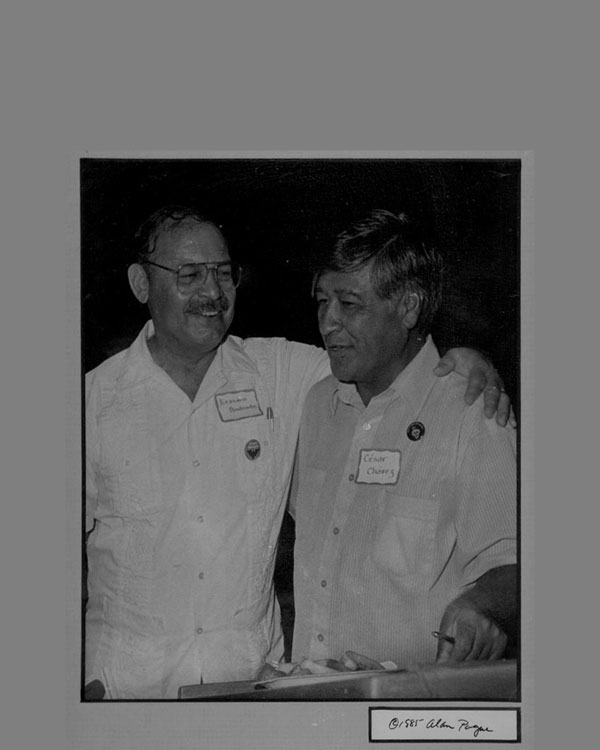
Erasmo Andrade with César Chavez, 1985. (Courtesy of the Andrade family.)
The accomplishments and dedication of each of these gentle giant lives deserve recognition; we owe them our gratitude for their lives’ work. I won’t focus on César Chavez; almost everyone knows about him now that there is a holiday in his name. Few people know about Dolores Huerta though, co-founder of United Farmworkers Union, who was just as active as he was, raised eleven children and was jailed for non-violent protests 22 times. I heard her speak at UTEP not too many years ago. Often times, women in social movements do not get the credit they deserve. But that will be a matter for another blog.
Albert Armendariz, Sr. was born in 1919. He served in WWII, and graduated from El Paso High and UTEP. After the war, he went to law school at the University of Southern California. In his long career, he was active in the leadership of LULAC (League of United Latin American Citizens) since its inception in 1951, one of the founders of MALDEF (Mexican American Legal Defense and Education Fund). Armendariz was an Immigration Judge for the Department of Justice for many years. He argued before the Supreme Court and was a Justice in the 8th District Court of Appeals here in El Paso. He brought a discrimination case against EPISD and won (Alvarado v. EPISD, 1971). He also advocated for hiring justice for Mexican Americans in the police and fire departments and other areas of city government.

Judge Albert Armendariz, Sr. (©U.S. Latino & Latina WWII Oral History Project)
Armendariz credited his activism to the time he spent in the military during the war. “Before the war, we were inconsequential,” Mr. Armendariz told the El Paso Times in 2005. “When we came back, we rose. We found out in the war that we had value, and we instilled that value in our people.”
Dennis Banks was born on the Leech Lake Indian Reservation in Minnesota in 1932, part of the Ojibwa nation. Along with Russell Means, Banks co-founded the American Indian Movement in 1968 which tried to address the concerns of urban Indians and the federal government’s responsibilities for respecting the treaties they made with various tribes. They were responsible for several “occupy” protests, including an occupation of Mt. Rushmore in 1971 and another in 1972 of the BIA (Bureau of Indian Affairs) building in Washington, DC, called the Trail of Broken Treaties. The most serious (and deadly) protest took place over a period of 71 days in 1973 at Wounded Knee, South Dakota. Wounded Knee was symbolic, the site of a December massacre of between 100 and 300 men, women and children in 1890 by the U.S. 7th Cavalry.
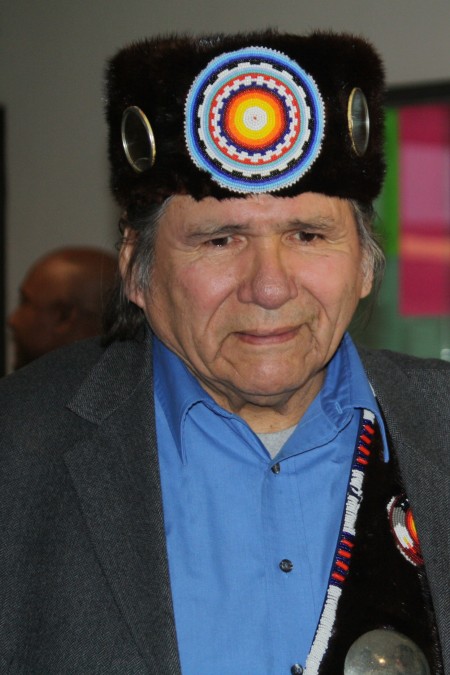
Dennis Banks, Co-founder of the American Indian Movement, 2012 at NMSU. (Cheryl Howard/Borderzine.com)
There were two other important marches, one in 1978 called the Longest Walk, echoing the roundup of Navajos in 1864 and relocating them hundreds of miles away to the Bosque Redondo. This march ended in an occupation of the Washington Monument, protesting 11 pieces of legislation and other currently relevant issues. The second Longest Walk took place in 2008, highlighting sovereignty issues as well as environmental concerns. Curiously, Dennis Banks credits some of his activism to time spent in the military. While in Japan, he saw how organized peaceful protest could result in changes in governmental policies, but he and other AIM activists also learned armed military tactics.
Erasmo Andrade was born in 1931 near Bruni, Texas, and grew up in San Antonio. He served in the Navy during the Korean War, and afterward graduated from St. Mary’s, began teaching public school and later went to Thurgood Marshall Law School. He spent three years in Turkey and Iran teaching ESL for the Department of Defense, and it was upon his return that he renewed his interest in social justice advocacy. Erasmo started as a union organizer for migrants, garbage collectors, and other marginalized groups. He also worked on behalf of farmworker conditions and voter rights in San Antonio and south Texas. Other causes he and Sally championed were mental health and prison reform.
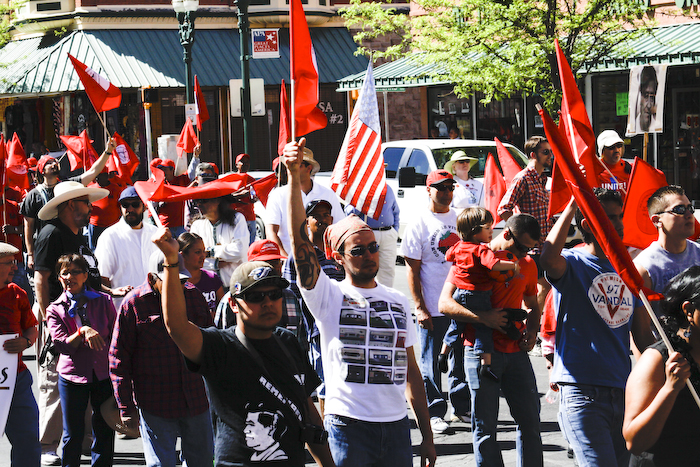
Erasmo and Sally at 2011 Cesar Chavez March, El Paso. Erasmo is behind the U.S. flag and Sally is just to the right. (Raymundo Aguirre/Borderzine.com)
After moving to Austin in 1973, Erasmo continued both farmworker and mental health involvement, while teaching government, history and economics at Austin high schools. In 1993 the family moved to El Paso, where Erasmo continued teaching and dedicating his life to the well-being of his community, especially in the arenas of social justice, health, and education. Last year Erasmo returned to Turkey where he and Sally were able to share the present country as well as his memories of it. His death is a loss to this community, and will be sorely felt, as was the loss of Judge Armendariz.
How would a young person get to meet a gentle giant such as these. Put your heart in the right place, choose the cause of justice and act. As Emerson once said: “Hitch your wagon to a star.” These giants are closer to the stars than we are, but we grow in their presence. And who knows, you may become one of them.
Erasmo died only a few days ago. Judge Armendariz died in 2007 at the age of 88. MALDEF President at the time, John Trasviña stated: “The best way to honor Judge Armendariz’s life is to carry on his work for justice and equality. Today’s generation of Latino leaders will make Judge Armendariz’s vision a reality.” Since Erasmo and I both share the same profession of teaching, I know we share this vision with both Armendariz and Banks.
The giants who made such a difference beginning in the sixties are getting old or have already passed. It is now up to a younger generation to take up the cause, because, as we see, without diligence, injustice can remain, can even worsen. Dennis Banks said at the end of his talk: “I don’t want to come back here, show another movie…in ten years and face the same issues. Young people need to step up and receive the staff.” Stand up for what you believe in. March for it.
That was the beginning and end of this March. There need to be more marches for justice. Like the March reenactment of the Selma to Montgomery march that first occurred 47 years ago and included a bridge crossing that then resulted in an event known as Bloody Sunday. This year, marchers were protesting voter suppression and Alabama’s immigration law. Like an annual march on César Chavez Day. Like a march for women’s rights, which seem to be increasingly threatened these days. Don’t wait for another March to roll around.
- Erasmo back in Turkey in 2011, (Courtesy of the Andrade family.)
- Banks and Josie Jimaréz-Howard deep in a discussion of history. (Cheryl Howard/Borderzine.com)
- Judge Albert Armendariz. (©Latino)
- Cheryl at 2011 Cesar Chavez March, El Paso. (Raymundo Aguirre/Borderzine.com)
- Erasmo Andrade with César Chavez, 1985. (Courtesy of the Andrade family.)
- Dennis Banks, Co-founder of the American Indian Movement, 2012 at NMSU. (Cheryl Howard/Borderzine.com)
- Erasmo and Sally at 2011 Cesar Chavez March, El Paso. Erasmo is behind the U.S. flag and Sally is just to the right. (Raymundo Aguirre/Borderzine.com)


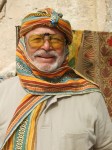
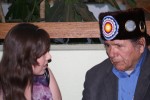
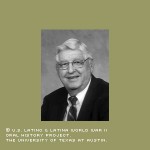
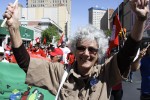
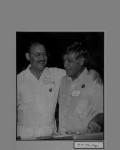
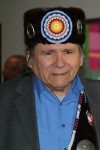
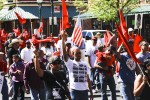

in ref to Dennis Banks,
It’s Amazing that anyone could walk with a man who has so much blood on his hands. Hopefully before long he will be in front of the Judge for the murder of the black activist Perry Ray Robinson Jr.
http://www.facebook.com/pages/Wounded-Knee-Incident-AIM-The-Truths/362949370395312
Justice for Perry Ray Robinson Jr.
http://www.facebook.com/pages/Justice-For-Perry-Ray-Robinson-Jr/204048599663045?sk=info
Perry Ray Robinson Jr., more commonly know as Ray Robinson was shot and killed inside Wounded Knee, South Dakota in 1973 during the occupation by the American Indian Movement. Ray was last seen being confronted by AIM security during April of 1973, including (names alleged so far) Leonard Crow Dog, Carter Camp, Dennis Banks, Frank Blackhorse, Stan Holder, Harry David Hill, Clyde Bellecourt and ot…hers in a Wounded Knee bunker after an arguement ensued over the oatmeal he was eating. Leonard Crow Dog led the group with a leg table or other wooden weapon of some kind. After entering the bunker to confront Robinson, one member of the group shot Robinson in the knee and he was then dragged outside, beaten and taken to the Wounded Knee Medical Clinic overseen by Madonna Gilbert Thunderhawk and Lorelie Decora Means and several other volunteer nurses and medics including several non-Indians, shoved into a closet where he bled to death.
In correspondence with AIM members, Carter Camp notes that he left Ray in Eagle Bunker after he had been shot in both legs.
Many witnesses to this event have been afraid to come forward, and several of those involved and named above were also involved with the 1975 execution of Annie Mae Pictou Aquash murdered in part, because of her knowledge of the Robinson murder. If you have information on the death of Ray Robinson please contact the office of South Dakota State Attorney General Marty Jackley at (605) 773-3331 or email at atghelp@state.sd.us
Erasmo will be dearly missed. A great human being committed to an important causa.
Thank you, Cheryl, for aiding us to commemorate these activistas – and their challenge to each of us to speak out AND to act for so many groups who are not heard in our world. Erasmo admired you as a brave, committed and effective university professor. Our family appreciates that you continue to teach us. Sally Andrade
@Geri Smith.
Ms. Smith,
All our hands are covered in blood. History is bloody. The indigenous people of this county have been systematically murdered, destroyed, and denied the rights they deserve. The policy of the US government has not bothered to understand their history or their way of life (and this is also true for other minority groups). Who, I ask, do you think is responsible for the murders of at least 150 Lakota near Wounded Knee Creek in 1890? Did you know several of the US Cavalry responsible for the unprovoked attack were awarded Medals of Honor? The Lakota, dancing the Ghost Dance, practicing their first amendment right of freedom of religion, were massacred. It isn’t that simple you say? No, it really isn’t. History isn’t simple. It also shouldn’t be a nationalist history that champions one side or the other. It should not deny the historical agency of one group. Dennis Banks and the AIM were not only confronting the injustices their people faced in the 1970s but the injustices their people had suffered all through history. Dennis Banks has spoken up for those that did not have a voice. He drew attention to the silencing of history. The battle for equality is often not peaceful. History is bloody. This is not excuse, but evidence that change is not simple, that events are often misrepresented, and that there is always more to a story than what is written. Ray Robinson’s death is a tragedy. A tragedy among many others. If we can learn anything from history it is that hate and blame are never the answer. We must learn to cleanse our old wounds through understanding history.
@ Josie, do not compare the historical profile of 1st nations to try and justify Dennis Banks, AIM leadership and members actions, it only shows you ignorance as to what acutally occured at Wounded Knee 2 and your lack of understanding how the negative after effects we combat on a daily basis.
“If the truth does NOT serve you, & you do not wish to believe the facts & accurate documentation-historical evidence, favoring AIMs lies, propaganda & myth makers account of events….that is your decision, but there are only two sides to this Lakota history & Tetuwan Lakota traditional Spiritual issue… against selling ceremony or conducting ceremony with blood of the innocent on AIMs hands.” -Looking Back Woman-
http://lookingbackwoman.wordpress.com/page/12/
did you know?
3-10-1972
one year prior to the Wounded Knee occupation, according hostage interview recordings , http://www.youtube.com/watch?v=-uBKvzPSo0g
initially Russel Means arrived at the museum and trading post with a bus borrowed from the local school district, he told the superintendent the usage was for school children going on a field trip. After the children vandalized the museum and trading post and in the process of being run off,one of the school kids told the owners “wait until the big guns get here” , The owners elected not to press charges on the school kids for the vandalism.
*** below is what followed the usage of children to vandalize , i.e the big guns showed up ***
3-10-1972
Ludington Daily News pg1;
Mar. 10, 1972 – Wounded Knee Museum Hit By Indian Raid
http://news.go…ogle.com/newspapers?nid=110&dat=19720310&id=CPtOAAAAIBAJ&sjid=LkwDAAAAIBAJ&pg=1931%2C4430104
(UPI) – About 400 Indians shouting burn, burn, burn – climaxed a week of protest Thursday night by storming a trading post and museum in Wounded Knee, roughing up operators of the two firms and making off with $50,000 worth of Indian artifacts.
(…)
The Indians arrived by bus and car, apparently from nearby Gordon, Neb. where between 600 and 1,000 had been staging a protest over the death there of Raymond Yellow Thunder, an Oglala Sious, at the hands of whites.
The occupation 1 year later according to hostage interviews.
http://www.youtube.com/watch?v=G8J3MkK0KRg
* discussion of AIM returning 1yr later in 1973, shooting , looting, stealing artifacts, desecrating head dress by tearing it apart for feathers
* shooting up exterior of resident homes and forcefully entering declaring the residents as political prisioners.
* hostages included disabled man in wheel chair, women, a child, a priest, etc…
* tied up the priest and forced him watch AIM members desecration of church alter to include urinating
* took chalice from alter and danced to drum and song throughout the nite
May 13, 1973: Matthew King, an Oglala elder and interpreter for Chief Frank Fools Crow, who spent time inside Wounded Knee and as a negotiator reports to the FBI that there is as many as “12” graves containing the bodies of several unidentified female corpses “just outside the perimeter of Wounded Knee.” (FBI Airtel 5/14/73 – FOI)
http://indiancountrynews.net/index.php?option=com_content&task=view&id=2101&Itemid=108&limit=1&limitstart=1
Easter Sunday Cross Hanging
perhaps we should talk about the man inside of wounded knee that was never seen again after he was accused of being an informant , tied to a cross on Easter Sunday and beaten by AIM, or maybe the priest that was tied up while AIM members desecrated the alter to include urinating , would you like for a post of Richard Two Elks interview on the Easter Day Cross hanging of the person Bellcourt named the “Manikan Man” ?
Richard Two Elk interview, … complete interview at;
http://indiancountrynews.net/index.php?option=com_content&task=view&id=24&Itemid=60&limit=1&limitstart=1
Two Elk has has over 25yrs of Journalism, and he was raised with Arlo Looking Cloud who was convicted for the murder of Annie Mae Pictou Aquash by the directives of AIM leadership , that leadership which includes Dennis who did nothing to stop the execution or assist with justice for Annie Mae, Perry Ray Robinson, and others as noted
**** Justice for Perry Ray Robinson Jr.
Perry Ray Robinson Jr., more commonly know as Ray Robinson was shot and killed inside Wounded Knee, South Dakota in 1973 during the occupation by the American Indian Movement. Ray was last seen being confronted by AIM security during April of 1973, including (names alleged so far) Leonard Crow Dog, Carter Camp, Dennis Banks, Frank Blackhorse, Stan Holder, Harry David Hill, Clyde Bellecourt and ot…hers in a Wounded Knee bunker after an arguement ensued over the oatmeal he was eating. Leonard Crow Dog led the group with a leg table or other wooden weapon of some kind. After entering the bunker to confront Robinson, one member of the group shot Robinson in the knee and he was then dragged outside, beaten and taken to the Wounded Knee Medical Clinic overseen by Madonna Gilbert Thunderhawk and Lorelie Decora Means and several other volunteer nurses and medics including several non-Indians, shoved into a closet where he bled to death.
In correspondence with AIM members, Carter Camp notes that he left Ray in Eagle Bunker after he had been shot in both legs.
Many witnesses to this event have been afraid to come forward, and several of those involved and named above were also involved with the 1975 execution of Annie Mae Pictou Aquash murdered in part, because of her knowledge of the Robinson murder. If you have information on the death of Ray Robinson please contact the office of South Dakota State Attorney General Marty Jackley at (605) 773-3331 or email at atghelp@state.sd.us
http://www.facebook.com/pages/Justice-For-Perry-Ray-Robinson-Jr/204048599663045
It would be nice for people start looking at the Truth in place of promoting the rhetoric by mouth from the teachings of AIM that is based on lies and deception
in closing, other for you to confirm;
Dennis Banks told AIM member John Trudell that Annie Mae was shot in the head. Banks knew this 2 weeks before discovery of bullet wound during 2nd autopsy March 9, 1976.
***
John Trudell’s testified at the Butler/Robideau trial June 22, 1976 and tells the court,
“Dennis (Banks) told me she had been shot in the back of the head. He told me this on February, about t…he 25th or 26th of February…. He told me this in California… I know it was within two days or so after they had found the body and I knew nothing about that.” “I was setting in the car with Dennis and he said, ‘You know that body they found? That is Annie Mae.’ I didn’t know about a body.” Vernon and Clyde Bellecourt are also in the car according to Trudell.
***
Dennis Banks told AIM member Darlene Nichols (Ka-mook) that Jane Doe found was Annie Mae approx 10 days prior to identity release on March 6, 1976 by the FBI.
Q. Did you ever see Anna Mae alive again?
A. No.
Q. When did you find out she was dead?
A. On February 24th.
…
… Q. How do you remember it was February 24th?
A. Because Dennis called me.
Q. Dennis Banks?
A. Yes.
above Testimony of AIM member Darlene Nichols (Banks ex-wife) in the Trial of Arlo Looking Cloud February 3, 2004
***
AIM to this day supports it’s members who were convicted between 2004 and 2010 for the execution of Annie Mae Pictou Aquash
AIM and it’s affiliates of support and defense, stopped Annie Mae from being returned to her homelands up until 2004 when her family broke free of the court injunctions thus making way for Annie Mae to return home.
Wounded Knee Incident & AIM – Truths
http://www.facebook.com/pages/Wounded-Knee-Incident-AIM-The-Truths/362949370395312
Justice for Annie Mae Pictou Aquash
http://www.facebook.com/groups/42504858894/
*****
so much for taking responsibility and being accountable huh? , this is what the youth have been taught from AIM, is that they can do whatever they want and walk away with lies and deception as they continue cycles of “self-genocide” , thanks for your support
Thank you very much Gerie Smith for your truth and for setting the history of these so-called “heros” straight. They are not heros or warriors or anything associated with truth or bravery…they are cowards and very dysfunctional people who are fame seekers and liars…The truth must be known world-wide with no misconceptions or plays of words to justify their ineptitude no matter who they are. These people do not represent all of Lakota, Dakota, Nakota or any other Indigenous Peoples although they say they do…Mitakuye Oyasin…